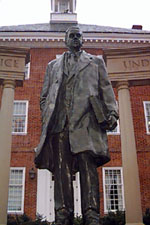
Bay Reflection
Monumental Leader
Thurgood Marshall stands tall among Annapolis landmarks
by M.L. Faunce
In life, Thurgood Marshall towered head and shoulders over men of lesser size and more modest goals. So it was only fitting that when Maryland sculptor Toby Mendez memorialized this native son of Baltimore, he would make his statue eight feet tall.
Placed in the middle of Lawyers Mall next to Maryland's Statehouse, the
commanding bronze sculpture and surrounding marble plaza invite the visitor
to sit a spell and reflect on the jurist many called "Mr. Civil Rights."
The first time I came upon the memorial, the shadow of a setting winter sun tricked me into thinking that the figures seated on benches facing the statue were real. On inspection, I found bronze sculptures of two children, symbolic of all the black children for whom Marshall argued to gain equal education and to overturn the policy of segregated schools.
Argument for the sake of education is nothing new for Americans. Thomas Jefferson championed universal education, even as he owned slaves (and quite possibly fathered slaves) who were denied theirs. In a nation that valued learning, separate but equal was the cornerstone of education.
Marshall, the great grandson of a slave, would successfully challenge the policy of segregation, first in the lower courts in Maryland and finally in the Supreme Court. He won his most important victory for school desegregation in 1954 in the landmark case Brown vs. the Board of Education.
I was in the fourth grade and remember the reaction. Some praised the decision as just and right and long overdue. But some of my classmates and their parents marched up and down our street in Washington protesting the decision. Many white families left the city.
Years later, I would have the chance to observe first-hand the man whose legal career so immensely pushed social change. By then, Marshall was old and gray and amply filled his flowing robes, the first African American appointed to the highest court in the land. The State of Alaska was arguing for its right to share its oil wealth dividend fund with long-term but not new residents.
I was stunned by Marshall's questions, which seemed rambling and non-germane to the subject at hand. Again and again, he invoked civil rights cases as if that were the case, pure and simple. In their written opinions, the other justices would agree, and Alaska lost its case: New residents could not be treated any different than longtime residents.
Thurgood Marshall made Americans think differently about race. But the unyielding defender of civil rights was, more accurately, an unyielding defender of individual rights. That's why the banner embracing the memorial to Marshall reads "Equal Justice Under the Law." To Marshall, that meant all Americans. And who could argue?
Learn more about Thurgood Marshall in the exhibit "A Lifetime of Leadership," on display 10-5:30 daily throughout Black History Month at the National Archives, Constitution Ave. between 7th and 9th streets NW, Washington, DC: 202/501-5000.
| Issue 5 |
Volume VII Number 5
February 4-10, 1999
New Bay Times
| Homepage |
| Back to Archives |